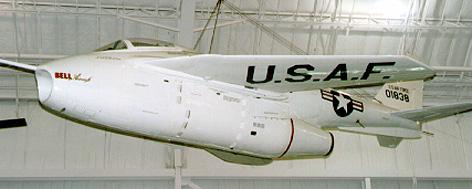Courtesy of Roberto Brackney, May 2003:
Ray was the husband of my late cousin Patricia Popson (nee: Mast), niece of my mother, Charlote Brackney (nee: Moore). He was killed during a trial of an experimental fighter plane out of Edwards Air Force Base in California in October 1953. My cousin was 8 1/2 months pregnant at the time.
He was given a hero’s burial because, when informed by Op Center that his plane was on fire, he radioed back that he thought he could land it. It crashed, exploded and he was instantly killed.
Patricia later remarried, to an engineer named William Orr, who adopted both the daughter Patty already had and the posthumously born son. Bill died in 1989 and Patricia died in 2000 after more than thirty-five years battling multiple sclerosis.
13 October 1953: X-5 Research Aircraft Crashed At Edwards Air Force Base, Killing The Test Pilot, Major Raymond Popson
Two X-5’s were constructed (USAF serial numbers 50-1838 and 50-1839), both were flown from Edwards AFB. The X-5’s variable sweep wing could be adjusted in flight from 20 to 60 degrees.
The first example was flown by the Air Force, and crashed on October 13, 1953, killing the pilot (USAF test pilot Major Raymond Popson). The other X-5 was flown by the NACA. Notable pilots that flew the X-5 include Neil Armstrong, Gen. Albert Boyd, Scott Crossfield, and Joseph Walker. The X-5 was retired from service in 1955, and is now on display at the USAF museum in Dayton, Ohio.
Major Raymond Popson, who would be killed on his first flight in aircraft #2 while conducting aggravated stall tests.
The little white X-5, perched on its stalky landing gear, was by no means an uncomplicated aircraft, nor were its flight characteristics in any way benign. In the NACA test program, the X-5 demonstrated severe stall-spin instability. Its stall and spin qualities were best described as “vicious.” Air Force test pilot Maj Raymond Popson, in fact, lost his life on 14 October, 1953, when the second X-5 crashed during a flight to study its ability to recover from a spin.
Michael Robert Patterson was born in Arlington and is the son of a former officer of the US Army. So it was no wonder that sooner or later his interests drew him to American history and especially to American military history. Many of his articles can be found on renowned portals like the New York Times, Washingtonpost or Wikipedia.
Reviewed by: Michael Howard

